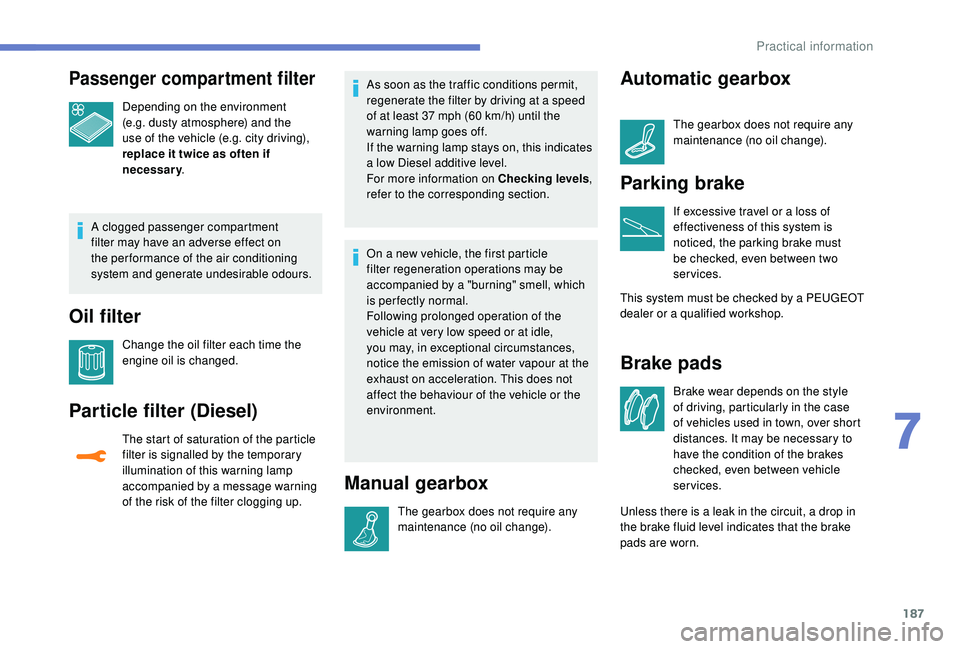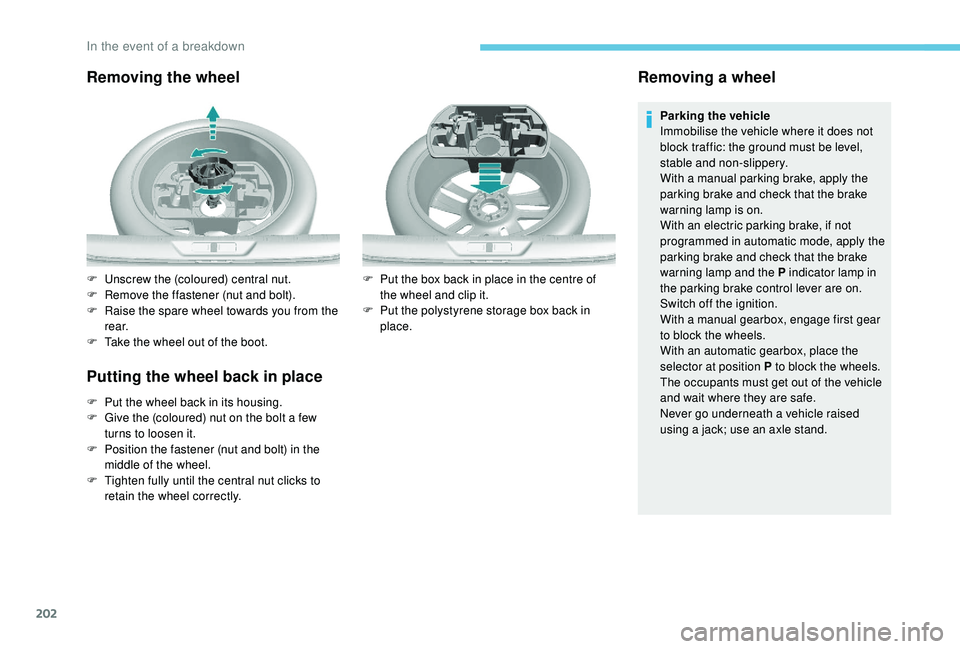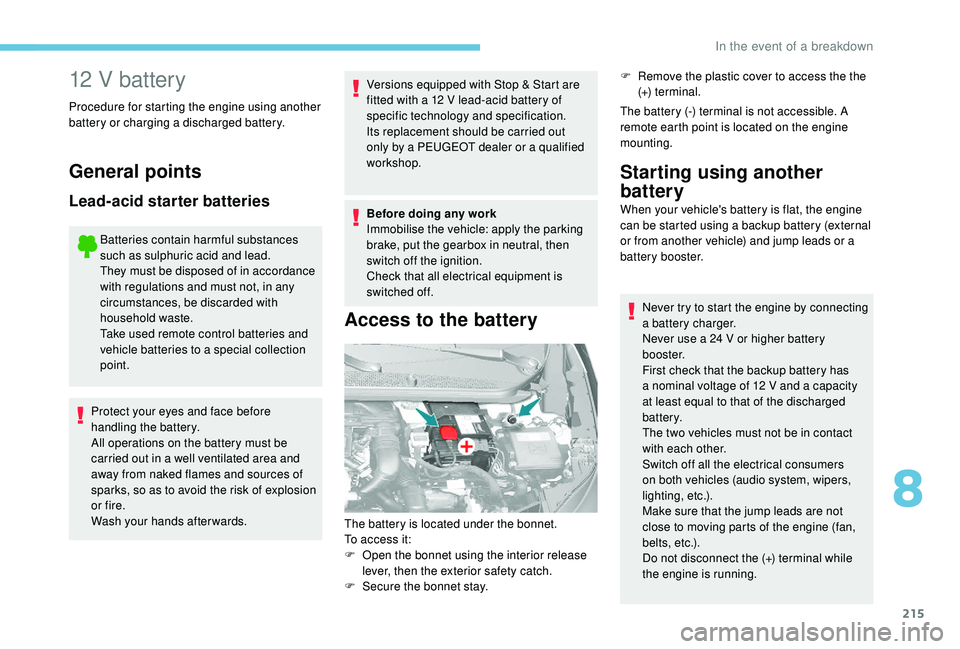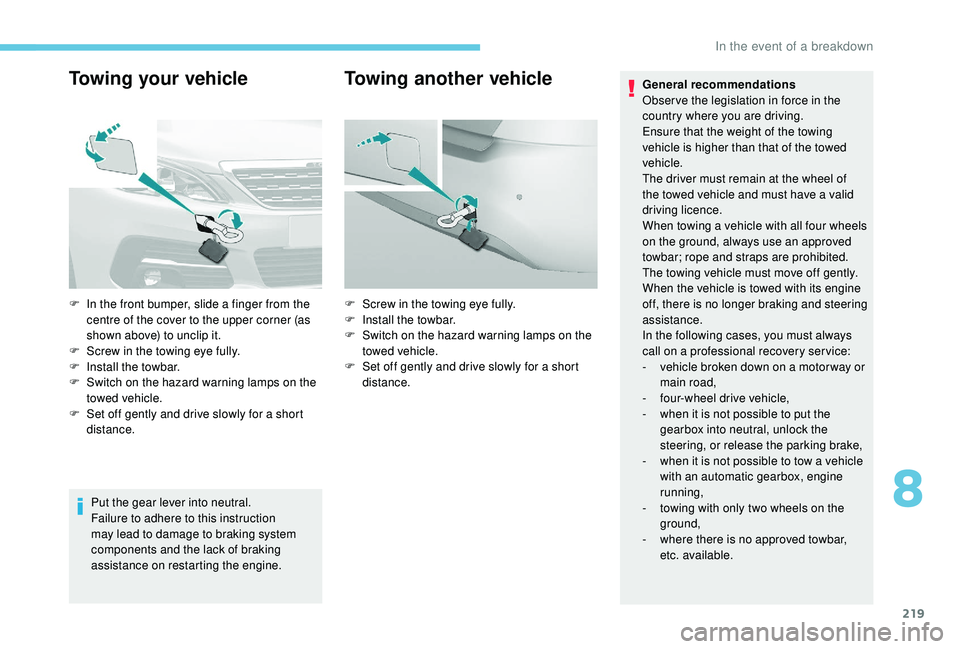Page 189 of 324

187
Passenger compartment filter
Depending on the environment
(e.g. dusty atmosphere) and the
use of the vehicle (e.g. city driving),
replace it twice as often if
necessary.
A clogged passenger compartment
filter may have an adverse effect on
the per formance of the air conditioning
system and generate undesirable odours.
Oil filter
Change the oil filter each time the
engine oil is changed.
Particle filter (Diesel)
The start of saturation of the particle
filter is signalled by the temporary
illumination of this warning lamp
accompanied by a message warning
of the risk of the filter clogging up. As soon as the traffic conditions permit,
regenerate the filter by driving at a speed
of at least 37
mph (60 km/h) until the
warning lamp goes off.
If the warning lamp stays on, this indicates
a low Diesel additive level.
For more information on Checking levels ,
refer to the corresponding section.
On a new vehicle, the first particle
filter regeneration operations may be
accompanied by a "burning" smell, which
is per fectly normal.
Following prolonged operation of the
vehicle at very low speed or at idle,
you may, in exceptional circumstances,
notice the emission of water vapour at the
exhaust on acceleration. This does not
affect the behaviour of the vehicle or the
environment.
Manual gearbox
The gearbox does not require any
maintenance (no oil change).
Automatic gearbox
The gearbox does not require any
maintenance (no oil change).
Parking brake
If excessive travel or a loss of
effectiveness of this system is
noticed, the parking brake must
be checked, even between two
services.
This system must be checked by a PEUGEOT
dealer or a qualified workshop.
Brake pads
Brake wear depends on the style
of driving, particularly in the case
of vehicles used in town, over short
distances. It may be necessary to
have the condition of the brakes
checked, even between vehicle
services.
Unless there is a leak in the circuit, a drop in
the brake fluid level indicates that the brake
pads are worn.
7
Practical information
Page 204 of 324

202
Removing the wheel
Putting the wheel back in place
F Put the wheel back in its housing.
F G ive the (coloured) nut on the bolt a few
turns to loosen it.
F
P
osition the fastener (nut and bolt) in the
middle of the wheel.
F
T
ighten fully until the central nut clicks to
retain the wheel correctly.
Removing a wheel
Parking the vehicle
Immobilise the vehicle where it does not
block traffic: the ground must be level,
stable and non-slippery.
With a manual parking brake, apply the
parking brake and check that the brake
warning lamp is on.
With an electric parking brake, if not
programmed in automatic mode, apply the
parking brake and check that the brake
warning lamp and the P indicator lamp in
the parking brake control lever are on.
Switch off the ignition.
With a manual gearbox, engage first gear
to block the wheels.
With an automatic gearbox, place the
selector at position P to block the wheels.
The occupants must get out of the vehicle
and wait where they are safe.
Never go underneath a vehicle raised
using a jack; use an axle stand.
F
U
nscrew the (coloured) central nut.
F
R
emove the ffastener (nut and bolt).
F
R
aise the spare wheel towards you from the
r e a r.
F
T
ake the wheel out of the boot. F
P
ut the box back in place in the centre of
the wheel and clip it.
F
P
ut the polystyrene storage box back in
place.
In the event of a breakdown
Page 217 of 324

215
12 V battery
Procedure for starting the engine using another
battery or charging a discharged battery.
General points
Lead-acid starter batteries
Batteries contain harmful substances
such as sulphuric acid and lead.
They must be disposed of in accordance
with regulations and must not, in any
circumstances, be discarded with
household waste.
Take used remote control batteries and
vehicle batteries to a special collection
point.
Protect your eyes and face before
handling the battery.
All operations on the battery must be
carried out in a well ventilated area and
away from naked flames and sources of
sparks, so as to avoid the risk of explosion
or fire.
Wash your hands afterwards. Versions equipped with Stop & Start are
fitted with a 12
V lead-acid battery of
specific technology and specification.
Its replacement should be carried out
only by a PEUGEOT dealer or a qualified
workshop.
Before doing any work
Immobilise the vehicle: apply the parking
brake, put the gearbox in neutral, then
switch off the ignition.
Check that all electrical equipment is
switched off.
Access to the battery
F Remove the plastic cover to access the the (+) terminal.
The battery (-) terminal is not accessible. A
remote earth point is located on the engine
mounting.
The battery is located under the bonnet.
To access it:
F
O
pen the bonnet using the interior release
lever, then the exterior safety catch.
F
S
ecure the bonnet stay.
Starting using another
battery
When your vehicle's battery is flat, the engine
can be started using a backup battery (external
or from another vehicle) and jump leads or a
battery booster. Never try to start the engine by connecting
a battery charger.
Never use a 24
V or higher battery
b o o s t e r.
First check that the backup battery has
a nominal voltage of 12
V and a capacity
at least equal to that of the discharged
battery.
The two vehicles must not be in contact
with each other.
Switch off all the electrical consumers
on both vehicles (audio system, wipers,
lighting, etc.).
Make sure that the jump leads are not
close to moving parts of the engine (fan,
belts, etc.).
Do not disconnect the (+) terminal while
the engine is running.
8
In the event of a breakdown
Page 221 of 324

219
Towing your vehicle
Put the gear lever into neutral.
Failure to adhere to this instruction
may lead to damage to braking system
components and the lack of braking
assistance on restarting the engine.
Towing another vehicleGeneral recommendations
Obser ve the legislation in force in the
country where you are driving.
Ensure that the weight of the towing
vehicle is higher than that of the towed
vehicle.
The driver must remain at the wheel of
the towed vehicle and must have a valid
driving licence.
When towing a vehicle with all four wheels
on the ground, always use an approved
towbar; rope and straps are prohibited.
The towing vehicle must move off gently.
When the vehicle is towed with its engine
off, there is no longer braking and steering
assistance.
In the following cases, you must always
call on a professional recovery ser vice:
-
v
ehicle broken down on a motor way or
main road,
-
f
our-wheel drive vehicle,
-
w
hen it is not possible to put the
gearbox into neutral, unlock the
steering, or release the parking brake,
-
w
hen it is not possible to tow a vehicle
with an automatic gearbox, engine
running,
-
t
owing with only two wheels on the
ground,
-
w
here there is no approved towbar,
etc. available.
F
I
n the front bumper, slide a finger from the
centre of the cover to the upper corner (as
shown above) to unclip it.
F
S
crew in the towing eye fully.
F
I
nstall the towbar.
F
S
witch on the hazard warning lamps on the
towed vehicle.
F
S
et off gently and drive slowly for a short
distance. F
S
crew in the towing eye fully.
F
I
nstall the towbar.
F
S
witch on the hazard warning lamps on the
towed vehicle.
F
S
et off gently and drive slowly for a short
distance.
8
In the event of a breakdown
Page 224 of 324
222
Engines and towed loads – PETROL
EnginesPureTech 110 S&S BVM5 PureTech 110 S&S BVM6 PureTech 110 BVM5
Gearboxes Manual 5-speedManual 6-speedManual 5-speed
Code EB2DT BE5EB2ADT STT MB6 EB2DTM BE5
Body style HatchbackSWHatchback SWHatchback SW
Model codes LPHNZBLRHNZB LPHNPPLRHNPP LPH N VA LR H N VA
Capacity (cm
3) 1,1 9 91,1 9 91,1 9 9
Max power: EC standard (kW) 818181
Fuel UnleadedUnleadedUnleaded
Braked trailer (within the GTW limit) (kg)
on a 10% or 12% gradient 1, 20 0
1,1 0 01,3151, 20 0 1, 20 0 1,1 0 0
Unbraked trailer (kg) 575630 575630 575630
Maximum authorised nose weight (kg) 757175 7175 71
Technical data
Page 225 of 324
223
EnginesPureTech 130 S&S BVM6 PureTech 130 S&S EAT6 PureTech 130 S&S EAT8
Gearboxes Manual 6-speedAutomatic 6-speed Automatic 8-speed
Code EB2DTS MCM/EB2ADTS MB6 EB2DTS AT6III EB2ADTS STT ATN8
Body style HatchbackSWHatchback SWHatchback SW
Model codes LPHNYH/
LPHNSP LRHNYH/
LRHNSP LPHNYW LRHNYW
LPHNSRLRHNSR
Capacity (cm
3) 1,1 9 91,1 9 91,1 9 9
Max power: EC standard (kW) 969696
Fuel UnleadedUnleadedUnleaded
Braked trailer (within the GTW limit) (kg)
on a 10% or 12% gradient 1,3 0 0
1, 20 01, 20 0 1,1 0 01,3 0 0 1, 20 0
Unbraked trailer (kg) 580 / 570 630 / 620 610635 610630
Maximum authorised nose weight (kg) 757175 7175 71
9
Technical data
Page 226 of 324
224
EnginesPureTech 130 BVM6PureTech 130 EAT6THP 135 EAT6
Gearboxes Manual 6-speedAutomatic 6-speed Automatic 6-speed
Code EB2DTSM ML6CEB2DTSM AT6IIIEP6FDTMD AT6III
Body style HatchbackSWHatchback SWHatchback
Model codes LPHNWG LRHNWGLPHNWVLRHNWV L35GLX
Capacity (cm
3) 1,1 9 91,1 9 91,59 8
Max power: EC standard (kW) 969699
Fuel UnleadedUnleadedUnleaded
Braked trailer (within the GTW limit) (kg)
on a 10% or 12% gradient 1,3 0 0
1, 20 0 1, 20 0 1,1 0 0 600
Unbraked trailer (kg) 580630 610635 600
Maximum authorised nose weight (kg) 757175 71 75
Technical data
Page 227 of 324
225
EnginesTHP 150 EAT6THP 165 EAT6PureTech 225 S&S EAT8
Gearboxes Automatic 6-speedAutomatic 6-speed Automatic 8-speed
Code EP6FDTM AT6IIIEP6FDTM AT6IIIEP6FADTX STT ATN8
Body style HatchbackSWHatchback SWHatchback SW
Model codes L35GXV L45GXVL35GY V L45GY VL35GGRL45GGR
Capacity (cm
3) 1,0981,59 81,59 8
Max power: EC standard (kW) 11 0121165
Fuel UnleadedUnleadedUnleaded
Braked trailer (within the GTW limit) (kg)
on a 10% or 12% gradient 600
6006006001,4 0 0 1,3 0 0
Unbraked trailer (kg) 600600600600 635695
Maximum authorised nose weight (kg) 757175 7175 71
9
Technical data